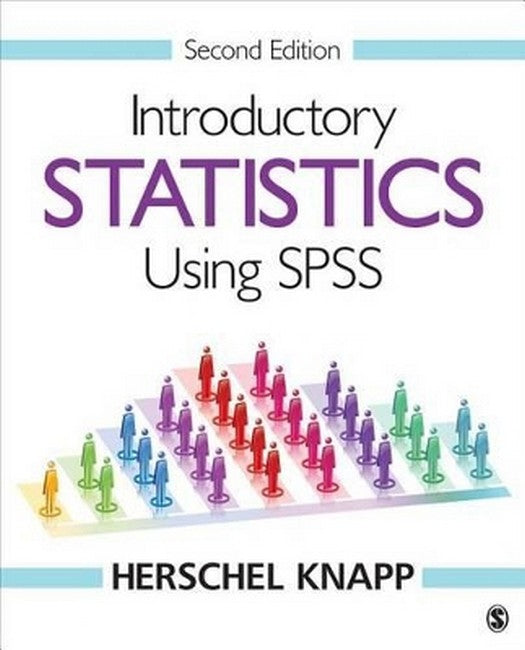Preface Acknowledgments About the Author PART I: STATISTICAL PRINCIPLES 1. Research Principles Learning Objectives Overview-Research Principles Rationale for Statistics Research Questions Treatment and Control Groups Rationale for Random Assignment Hypothesis Formulation Reading Statistical Outcomes Accept or Reject Hypotheses Variable Types and Levels of Measure Continuous Interval Ratio Categorical Nominal Ordinal Good Common Sense Key Concepts Practice Exercises 2. Sampling Learning Objectives Overview-Sampling Rationale for Sampling Time Cost Feasibility Extrapolation Sampling Terminology Population Sample Frame Sample Representative Sample Probability Sampling Simple Random Sampling Stratified Sampling Proportionate and Disproportionate Sampling Systematic Sampling Area Sampling Nonprobability Sampling Convenience Sampling Purposive Sampling Quota Sampling Snowball Sampling Sampling Bias Optimal Sample Size Good Common Sense Key Concepts Practice Exercises 3. Working in SPSS Learning Objectives Video Overview-SPSS Two Views: Variable View and Data View Variable View Name Type Width Decimals Label Values Missing Columns Align Measure Role Data View Value Labels Icon Codebook Saving Data Files Good Common Sense Key Concepts Practice Exercises PART II: STATISTICAL PROCESSES 4. Descriptive Statistics Learning Objectives Videos Overview-Descriptive Statistics Descriptive Statistics Number (n) Mean () Median Mode Standard Deviation (SD) Variance Minimum Maximum Range SPSS-Loading an SPSS Data File Run SPSS Data Set Test Run SPSS-Descriptive Statistics: Continuous Variables (age) Statistics Tables Histogram With Normal Curve Skewed Distribution SPSS-Descriptive Statistics: Categorical Variables (gender) Statistics Tables Bar Chart SPSS-Descriptive Statistics: Continuous Variable (age) Select by Categorical Variable (gender)-Female or Male Only SPSS-(Re)Selecting All Variables Good Common Sense Key Concepts Practice Exercises 5. t Test and Mann-Whitney U Test Learning Objectives Videos Overview-t Test Example Research Question Groups Procedure Hypotheses Data Set Pretest Checklist Pretest Checklist Criterion 1-Normality Pretest Checklist Criterion 2-n Quota Pretest Checklist Criterion 3-Homogeneity of Variance Test Run Results Pretest Checklist Criterion 2-n Quota Pretest Checklist Criterion 3-Homogeneity of Variance p Value Hypothesis Resolution a Level Documenting Results Type I and Type II Errors Type I Error Type II Error Overview-Mann-Whitney U Test Test Run Results Good Common Sense Key Concepts Practice Exercises 6. ANOVA and Kruskal-Wallis Test Learning Objectives Videos Layered Learning Overview-ANOVA Example Research Question Groups Procedure Hypotheses Data Set Pretest Checklist Pretest Checklist Criterion 1-Normality Pretest Checklist Criterion 2-n Quota Pretest Checklist Criterion 3-Homogeneity of Variance Test Run Results Pretest Checklist Criterion 2-n Quota Pretest Checklist Criterion 3-Homogeneity of Variance Comparison 1-Text : Text With Illustrations Comparison 2-Text : Video Comparison 3-Text With Illustrations : Video Hypothesis Resolution Documenting Results Overview-Kruskal-Wallis Test Test Run Results Good Common Sense Key Concepts Practice Exercises 7. Paired t Test and Wilcoxon Test Learning Objectives Videos Overview-Paired t Test Pretest/Posttest Design Step 1: Pretest Step 2: Treatment Step 3: Posttest Example Research Question Groups Procedure Step 1: Pretest Step 2: Treatment Step 3: Posttest Hypotheses Data Set Pretest Checklist Pretest Checklist Criterion 1-Normality of Difference Test Run Results Hypothesis Resolution Documenting Results ?% Formula Overview-Wilcoxon Test Test Run Results Good Common Sense Key Concepts Practice Exercises 8. Correlation and Regression-Pearson and Spearman Learning Objectives Videos Overview-Pearson Correlation Example 1-Pearson Regression Research Question Groups Procedure Hypotheses Data Set Pretest Checklist Pretest Checklist Criterion 1-Normality Test Run Correlation Regression (Scatterplot With Regression Line) Results Scatterplot Points Scatterplot Regression Line Pretest Checklist Criterion 2-Linearity Pretest Checklist Criterion 3-Homoscedasticity Correlation Hypothesis Resolution Documenting Results Negative Correlation No Correlation Overview-Spearman Correlation Example 2-Spearman Correlation Research Question Groups Procedure Hypotheses Data Set Pretest Checklist Test Run Results Hypothesis Resolution Documenting Results Alternative Use for Spearman Correlation Correlation Versus Causation Overview-Other Types of Statistical Regression: Multiple Regression and Logistic Regression Multiple Regression (R2) Logistic Regression Good Common Sense Key Concepts Practice Exercises 9. Chi-Square Learning Objectives Video Overview-Chi-Square Example Research Question Groups Procedure Hypotheses Data Set Pretest Checklist Pretest Checklist Criterion 1-n = 5 per Cell Test Run Results Pretest Checklist Criterion 1-n = 5 per Cell Hypothesis Resolution Documenting Results Good Common Sense Key Concepts Practice Exercises PART III: DATA HANDLING 10. Supplemental SPSS Operations Learning Objectives Data Sets Overview-Supplemental SPSS Operations Generating Random Numbers Sort Cases Data Set Select Cases Data Set Recoding Data Set Importing Data Importing Excel Data Data Set Importing ASCII Data (Generic Text File) Data Set SPSS Syntax Data Set Data Sets Good Common Sense Key Concepts Practice Exercises Glossary Index
Request Academic Copy
Please copy the ISBN for submitting review copy form
Description
"This student-friendly text, coupled with an ample number of practice exercises and instructional videos for each chapter, provided my students with the resources to become proficient in using SPSS to perform and interpret the statistical analyses covered in the course. In addition, this text emphasizes and models the written communication of results and conclusions derived from research." -- Linda Ritchie "I find the videos extremely helpful. Of particular note was the pre-test checklist. This list helps students to understand what criteria need to be met for the test to be used. The directions provided are incredibly detailed and provide ample guidance to students with limited computer skills....Overall, I found this book to be the best of those that I have used or reviewed." -- Christopher Salvatore "This is one of the best introductory SPSS texts on the market. It is easy to read, clear, concise and does not overwhelm the reader with abstract statistical theory. The exercises and examples are good and will be really useful both in class and for homework assignments. The online resources are a great addition and really help in understanding the material in the text." -- Barbra Teater

